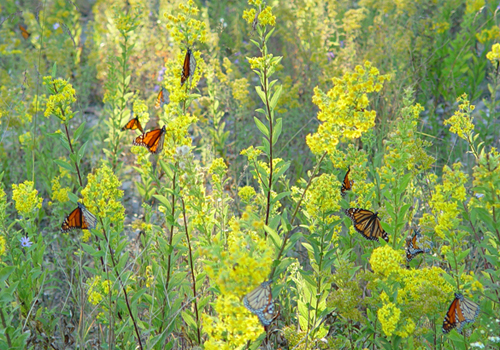
Are Milkweeds Enough For Monarchs

Monarchs and milkweeds. The two go together like fish and water or little boys and mud. You just can’t have the first without the second. The story of the monarch is one of those fascinating intricacies of nature. Being a butterfly, monarchs go through that life cycle process called metamorphosis that we all learned in elementary school: the egg hatches into a caterpillar, the caterpillar pupates into a chrysalis, from which eventually emerges a butterfly. So, where does the oh-so-important milkweed enter the picture? Well, it is only important for a little while to the monarch. As a caterpillar, the monarch exclusively consumes milkweed plants. Eliminate the milkweeds, and you eliminate the monarchs. And, it is all because of the caterpillar.
Interestingly, monarchs find other benefits in consuming the milkweed plants, which if consumed in such large quantities by most other critters would be toxic. They accumulate the toxic compounds in their body, which makes them toxic to potential predators both as a caterpillar and as a butterfly. With the monarch’s striking color pattern, it is an easy lesson for the predators to learn after they eat one and then sit around with a belly ache. “That pretty butterfly is no good for eatin’.”
As a butterfly, the monarch is much less picky. They eagerly seek out nectar from many plants to sustain them during their journey and the laying of eggs. So, milkweeds aren’t enough for the monarchs; they need the nectar-producing plants as well. Monarchs do seem to have some favorites from which they collect nectar including many of the goldenrod and aster species. We have observed hundreds of monarchs clustering onto some of these plants in the fall as they migrate south.
Just as a single-minded focus on milkweeds won’t be the answer to the monarch’s food needs, it also won’t serve the other pollinator and wildlife species very well. The native grasslands historically had a variety of native plants, and this suited the native wildlife quite well. To recreate ideal habitat, we need to have a large variety of native plants in our plantings as well. For pollinator focus, it is important to have flowers from spring through fall so they can find a pollen or nectar meal any time during the growing season.

If you are interested in providing habitat for pollinators or other wildlife species, keep this in mind as you plan native plantings. Even if the primary focus of the planting is not wildlife, such as a landscaping, forage, or restoration project, wildlife and pollinators can still be a secondary focus.


